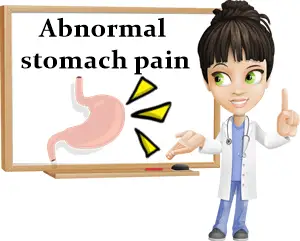What constitutes an abnormal stomach pain? Well, stomachs pain are all abnormal since they signal something is not right. Whether it’s heartburn or indigestion pain, colic, muscle cramps because of diarrhea or air getting trapped in the intestinal tract, a dull stomach pain caused by an ulcer or anything else, it’s important to keep track of stomach pains. Knowing if a type of stomach pain you are having is an infrequent occurrence or if it’s become something of a regular episode as well as attempting to identify triggers can help determine what is causing it in order to effectively treat it.
The abdominal area houses plenty of organs, from the stomach to the liver, gallbladder, pancreas, kidneys and more. Sometimes it’s difficult to tell where the pain may come from, especially considering pain can radiate, meaning it can be felt in a place other than its place of origin. For example, it’s extremely common to mistake some forms of stomach pain for kidney pain or lower back pain simply because it radiates to the lower back.

How the pain presents can help determine where it’s coming from and, more important, what you can do about it. Pangs (sudden, sharp pain), stings, spasms (painful or not), cramps, aches, throbs, pressure pain, burning pain or tenderness upon touch each occur in specific circumstances, brought on by specific causes. The location of the pain is possibly the biggest indicator of the cause behind it. Normally, the abdominal area is divided into four areas called the upper right quadrant, the lower right quadrant (basically the upper and lower right side) and the upper left quadrant and the lower left quadrant (essentially the upper and lower left side).
But stomach pain may be felt around the belly button or above it too. Stomach pain may also be experienced in the middle upper part of the abdomen, above the belly button and below the chest, called the epigastric area (an area overlying the stomach). Lastly, the duration of the pain can further provide answers as to what is going on. According to duration, pain is either acute (sudden onset, often strong in intensity, but short-lasting and may be episodic) or chronic (occurring at regular or irregular intervals for months).
What are some abnormal stomach pains?
While no stomach pain is normal, some types are worth keeping an eye on because they may indicate potentially serious underlying causes. Below are some common examples of abnormal pains in the stomach and accompanying symptoms that may warrant investigation:
1) Severe, constant burping and stomach pain. If you are constantly burping and feeling pain roughly in the upper middle part of the abdomen, it may just be something you ate or have been eating in the last few days (particularly foods that ferment and cause air to accumulate in the intestines). But continuous, excessive burping with a usually dull stomach pain is a also a sign of gastritis – inflammation of the stomach lining. It may be acute or chronic, caused by poor eating or an H. pylori infection, but it warrants a visit to your doctor’s.

2) Pain in chest. Upon experiencing pain in the chest or roughly the upper, middle part of the stomach area, the first thing most people would think about is they’re having either indigestion or a heart attack. It could be either, but if this particular type of pain is recurrent and you know you’ve been eating poorly (chocolate, spicy foods, fermented foods, coffee, alcohol), then it might just be acid reflux disease, or GERD. See what foods to eat and to avoid for acid reflux.
Depending on its severity, the chest pain could feel like a burning sensation (most common), cramps or even pangs (sharp, sudden pain). If it’s really acid reflux, you may also be experiencing stomach juices flowing back up into the esophagus (regurgitation) and a bad, bitter, acidic or metallic taste in the mouth in addition to the heartburn. If it’s a heart attack, look out for symptoms such as tiredness, shortness of breath, pain or tingling in left arm, nausea, cold sweats or feeling faint.
3) Belly button pain. Occasional pain around the belly button can easily be caused by indigestion and can appear as an intense burning sensation that may take a couple of hours to subside. But if it occurs suddenly and is apparently not connected to something you’ve eaten, doesn’t subside or gets worse, then you could be looking at appendicitis. Other symptoms to look out for include fever, sweats, nausea, vomiting and lack of appetite.
4) Sudden, sharp stomach pain. If you periodically experience sharp stomach pain that comes and goes, then it could be gastritis. Sharp pain in the upper middle part of the abdomen, or the epigastric area overlying the stomach, is indication of inflammation of the stomach lining. If it’s gastritis, the pain is more likely to appear in between meals or if you skip a meal or let too much time pass between meals. Heartburn and acid reflux, severe bloating, excessive belching and hiccups, frequent indigestion are other symptoms that indicate gastritis. Other more serious causes are also possible which is why it’s good to have this type of stomach pain investigated by your doctor.
5) Painful stomach cramps, bloating and excessive burping. If you regularly get painful stomach cramps (that may go away if you have a bowel movement) along with visible bloating and excessive burping, and it’s not in response to just some foods, then it’s possible you are dealing with an inflammatory condition such as IBS or Crohn’s disease. Other telling symptoms indicating an inflammatory bowel condition include changes in bowel movement habits such as constipation or diarrhea or both, urgency to have a bowel movement, presence of mucus in stools and nausea. So if your stomach hurts and bloats every time after eating, it’s worth having some tests to determine if you are dealing with an inflammatory bowel condition, especially if this has been going on for weeks or months already.
6) Dull pain on the right side. It may be something as harmless as constipation. Hard, rough, dry, bulky stools create pressure which translates into a dull pain, usually on the right side or affecting the entire lower abdomen. But the pain should go away after a bowel movement. If it doesn’t, other causes are possible, including impacted stools (stools that have become so dry and hard they are difficult to pass without the help of stool softeners) and appendicitis. Appendicitis pain can be experienced in the lower right part of the abdomen or around or above the belly button, an area overlying the stomach. But appendicitis pain does not subside, but rather grows worse and other symptoms such as fever, sweats, chills, nausea, vomiting also occur.
7) Continuous dull or burning stomach pain. If the pain is felt in the middle upper part of the abdomen, above the belly button (called the epigastric area, overlying the stomach) and sometimes also overlying the belly button and it’s continuous, getting worse in between meals, then it’s possible it’s a stomach ulcer. The pain can be so severe it can wake you up from your sleep at night and is stronger if your stomach is empty. Nausea, vomiting sensation, heartburn and overall a bad reaction to certain foods (spicy, fatty, fried, heavy, fermented) are other symptoms that indicate a possible ulcer.
Conclusion
Stomach pain is always abnormal, but some pains are less of a reason for concern than others. Indigestion, heartburn and acid reflux are easier to identify and even treat, but an ulcer, an inflammatory condition such as IBS, intestinal parasites, tumors or even chronic constipation may present themselves in a way that doesn’t necessarily make you think about them right away. So if you experience stomach pain with a sudden onset that you cannot connect to something you’ve recently eaten or done, if that pain gets progressively worse or if you experience worrisome symptoms such as fever, chills, vomiting after a meal or first thing when you wake up in the morning, lack of appetite, jaundice, unintentional weight loss, red, brown or black stools, then see your doctor for some tests.
